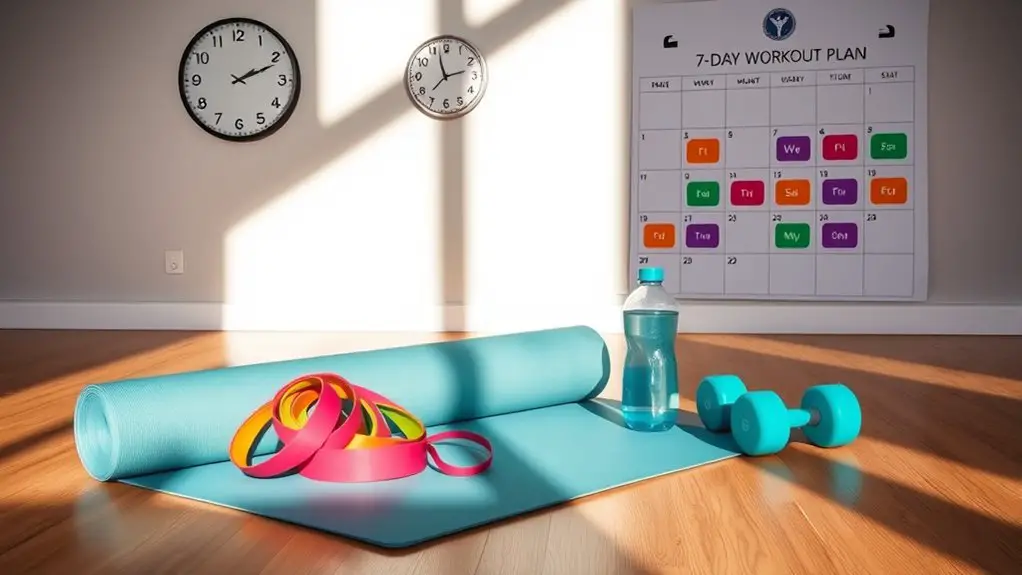7-Day Workout Plan for Fat Loss

Looking to shed pounds? Try this 7-day workout plan for fat loss. You’ll engage different muscle groups daily with a mix of strength training, HIIT, and cardio. Start with full body strength exercises, then move to high-intensity intervals, and focus on your core. Don’t forget active recovery and finish strong with a full body circuit challenge. Stay consistent, listen to your body, and hydrate well. Stick around to discover more tips and tricks to enhance your journey!
Overview of the 7-Day Workout Plan

If you’re looking to shed some pounds and boost your fitness, this 7-Day Workout Plan is designed just for you. It’s structured to keep you engaged and focused on your fitness goals while ensuring your safety during each session. Each day targets different muscle groups and incorporates a mix of strength training and cardio, providing a balanced approach to fat loss.
To maintain your workout motivation throughout the week, you’ll find a variety of exercises that challenge you without overwhelming your body. Remember, it’s vital to listen to your body; modify any movements as needed to prevent injury. Additionally, incorporating skipping rope into your routine can enhance calorie burn and support your weight loss efforts.
This plan also emphasizes the importance of proper hydration and nutrition, which play a significant role in achieving your fitness goals. By the end of the week, you’ll not only feel accomplished but also energized to continue your journey toward a healthier lifestyle.
Day 1: Full Body Strength Training
Day 1 kicks off your 7-Day Workout Plan with a full body strength training session that’s designed to activate all major muscle groups. You’ll focus on safe and effective strength techniques, ensuring you maintain proper form throughout each exercise. Start with compound movements like squats, deadlifts, and bench presses to engage multiple muscles at once. Remember to listen to your body; if something feels off, don’t hesitate to modify the exercise or take a break. Performing each movement with control will help minimize the risk of injury. Aim for 3 sets of 8-12 repetitions for each exercise, allowing adequate rest between sets for muscle recovery. Incorporating Romanian deadlifts into your routine can provide a safer alternative to traditional stiff leg deadlifts, reducing lower back strain while still effectively targeting the hamstrings. Hydration is key, so drink plenty of water before, during, and after your workout. By prioritizing safety and recovery, you’ll set a solid foundation for the rest of your week and your fat loss journey.
Day 2: High-Intensity Interval Training (HIIT)

Day 2 focuses on High-Intensity Interval Training (HIIT), a powerful way to boost your fat loss. You’ll discover the benefits of HIIT, explore some sample exercises, and learn essential safety tips to keep your workouts effective and injury-free. Get ready to maximize your results in a shorter amount of time! Additionally, incorporating skipping rope into your routine can enhance your HIIT sessions by providing a full-body workout that elevates your heart rate and burns calories efficiently.
Benefits of HIIT
While many workout routines can help you shed fat, High-Intensity Interval Training (HIIT) stands out for its efficiency and effectiveness. One of the key HIIT benefits is its ability to provide a significant metabolic boost, which can help you burn more calories even after your workout ends. This post-exercise calorie burn, known as the afterburn effect, makes HIIT a powerful tool in your fat loss journey.
Moreover, HIIT workouts can typically be completed in a shorter time frame compared to traditional cardio, making it easier to fit into your schedule. Plus, the varied intensity levels can help keep your workouts engaging and enjoyable. Remember to listen to your body and prioritize safety to maximize these benefits while minimizing any risk of injury.
Sample HIIT Exercises
With the benefits of HIIT in mind, it’s time to put those principles into action. You can start with a simple routine: 30 seconds of jumping jacks followed by 30 seconds of rest, then 30 seconds of burpees and another rest. This combination showcases HIIT variations that can elevate your heart rate effectively. Next, try mountain climbers for 30 seconds, resting again before finishing with high knees. Remember to listen to your body; if something feels off, take a longer break or modify the exercise. The goal is to push yourself while staying safe. Incorporating these sample HIIT exercises not only maximizes your workout efficiency but also helps you reap the HIIT benefits, making your fat loss journey more effective.
Safety Tips for HIIT
When engaging in High-Intensity Interval Training (HIIT), keeping safety in mind is essential for maximizing your results while minimizing the risk of injury. Here are some important HIIT precautions to follow:
| Precaution | Description |
|---|---|
| Warm Up Importance | Always start with a dynamic warm-up. |
| Listen to Your Body | Don’t push through pain; rest if needed. |
| Stay Hydrated | Drink water before, during, and after. |
| Use Proper Form | Focus on technique to prevent injuries. |
| Cool Down | End with stretching to aid recovery. |
Day 3: Core and Abs Focus

On Day 3, it’s all about tightening your core and sculpting those abs. You’ll learn effective exercises that target your midsection while also exploring how nutrition plays an essential role in achieving that defined look. Let’s get started on strengthening your core and refining your diet for maximum results! Engaging in activities like skipping rope not only helps tone your abs but also improves coordination and balance.
Effective Core Exercises
While you might think of core exercises as just sit-ups and planks, there’s a whole range of effective movements that can help you strengthen your abs and improve overall stability. Start with plank variations, like side planks or plank jacks, which engage multiple muscle groups while enhancing core stability. Incorporating a stability ball into your routine can also elevate your workouts—try stability ball rollouts or ball passes for added challenge. Remember to focus on controlled movements to prevent injury, and always listen to your body. If something feels uncomfortable, modify your approach or take a break. By integrating these core exercises, you’ll build a solid foundation that supports your fitness goals while ensuring safety and effectiveness.
Nutrition for Ab Definition
To achieve defined abs, your nutrition plays an essential role, as what you eat can greatly impact your body composition. Implementing effective nutrition strategies is vital. Focus on meal timing; try to eat smaller, balanced meals throughout the day to keep your metabolism active. Incorporate healthy snacks like fruits or nuts to avoid unhealthy cravings. Prioritize lean protein sources, such as chicken, fish, or legumes, to support muscle growth. Also, stay hydrated—water helps with digestion and keeps you feeling full. Consider carb cycling for ideal energy while maintaining portion control. By combining these elements, you’ll not only support your workouts but also enhance your results, leading to the ab definition you’re aiming for.
Day 4: Active Recovery and Flexibility
After three intense days of workouts, it’s essential to give your body a chance to recover. Day 4 focuses on active recovery and flexibility routines. These gentle activities help your muscles heal and prevent injury, ensuring you’re ready for the next challenge.
Here’s a simple table to guide your recovery:
| Active Recovery Activity | Duration | Benefits |
|---|---|---|
| Light Jogging | 20 mins | Boosts circulation |
| Yoga | 30 mins | Enhances flexibility |
| Stretching | 15 mins | Relieves tension |
Incorporating these activities lets you maintain movement without overexertion. Remember, it’s not just about working hard; it’s about working smart. Prioritize your safety and listen to your body. Enjoy this day to rejuvenate and recharge, setting the stage for the workouts ahead. Additionally, incorporating jump rope exercises can further aid in enhancing your cardiovascular health during recovery days.
Day 5: Lower Body Blast
Get ready for Day 5: Lower Body Blast, where you’ll focus on sculpting and strengthening your legs and glutes. Today’s lower body workouts are designed to engage your muscles effectively while ensuring your safety. Start with a warm-up to get your blood flowing and prepare your body for strength training.
Begin with squats, targeting your quads and glutes—make sure to keep your knees aligned with your toes. Next, incorporate lunges to work on stability and strength. Don’t forget to engage your core throughout these movements. Add deadlifts to round out your routine, focusing on proper form to protect your back. Consider integrating alternative exercises to enhance your lower body strength and stability.
Finish with some calf raises to strengthen those often-overlooked muscles. Always listen to your body; if something feels off, it’s okay to modify or take breaks. Remember, consistency is key to achieving fat loss while building strength. Enjoy the burn, and stay safe!
Day 6: Cardio Endurance
As you immerse yourself in Day 6: Cardio Endurance, you’ll focus on elevating your heart rate and enhancing your stamina. Start with a warm-up to prepare your body and reduce the risk of injury. Incorporate various cardio techniques like jogging, cycling, or swimming to keep things interesting. Aim for a steady pace that challenges you but allows you to maintain control.
During your endurance training, listen to your body; if you feel overly fatigued or experience discomfort, it’s essential to slow down or take breaks. Gradually increase your duration and intensity as your fitness improves. Aiming for at least 30-45 minutes of continuous activity can greatly boost your cardiovascular health. Consider adding jump rope workouts to your routine for an effective way to elevate heart rate and improve overall fitness.
Finish with a cool down to help your heart rate return to normal and mitigate muscle soreness. Remember, consistency is key, so stay committed, and you’ll see improvements in your overall endurance and fat loss journey.
Day 7: Full Body Circuit Challenge
On Day 7, you’ll tackle a Full Body Circuit Challenge designed to engage multiple muscle groups and boost your metabolism. This workout combines strength and cardio for a thorough session, ensuring you get the circuit training benefits you’re after. You’ll perform a series of exercises—like squats, push-ups, and lunges—back-to-back with minimal rest to keep your heart rate up.
Start with a warm-up to prepare your body and reduce injury risk. Focus on maintaining proper form throughout each movement, and listen to your body. If you need a break, take it. This full body workout is about challenging yourself safely. Incorporating skipping rope into your routine can further enhance your cardiovascular fitness and aid in weight loss.
As you complete each circuit, aim for a balance between intensity and safety. By the end, you’ll feel accomplished and energized, knowing you’ve wrapped up the week strong. Remember, consistency is key to achieving your fat loss goals!
Frequently Asked Questions
How Many Calories Should I Consume for Optimal Fat Loss?
Did you know that a safe caloric deficit of 500 to 1000 calories a day can help you lose about 1 to 2 pounds a week? To determine how many calories you should consume for ideal fat loss, consider your metabolism and activity level. Aiming for a slight caloric deficit while incorporating metabolism-boosting foods can accelerate fat loss. Always prioritize safety, so it’s best to consult a professional for personalized advice.
Can I Substitute Exercises in the Workout Plan?
Absolutely, you can substitute exercises in your workout plan! Exercise variation is key to keeping things interesting and preventing plateaus. Just make certain the modifications you choose align with your fitness level and goals. If you’re unsure about a substitution, consider consulting a professional trainer to guarantee safety and effectiveness. Remember, the goal is to stay active and engaged while minimizing the risk of injury, so listen to your body and adapt as needed!
What Should I Eat Before and After Workouts?
Imagine you’re gearing up for a tough workout, and your energy levels are low. To fuel your body, consider a pre-workout snack like a banana with almond butter. It provides quick energy and healthy fats. After your workout, aim for a post-workout meal that includes lean protein, like grilled chicken, paired with quinoa and veggies. This combo helps repair muscles and replenishes nutrients. Staying safe and nourished is key to effective workouts!
How Much Water Should I Drink During Workouts?
During workouts, staying hydrated is vital for peak performance. Aim to drink about 7 to 10 ounces of water every 10 to 20 minutes. Remember, your body loses fluids through sweat, so it’s important to replenish them to maintain energy levels and avoid dehydration. Consider your workout intensity and duration, and listen to your body’s signals. Following these hydration tips will help guarantee you stay safe and perform at your best.
Is It Safe to Workout Every Day for Fat Loss?
Imagine a car that’s never given a break; it’ll eventually sputter and stall. That’s how your body feels without proper workout recovery. Daily exercise is great for fat loss, but it’s essential to listen to your body. Overtraining can lead to injuries and burnout. Aim for a mix of activity and rest days to keep your progress steady and safe. Balance is key; even a high-performance vehicle needs time to refuel and recharge.





